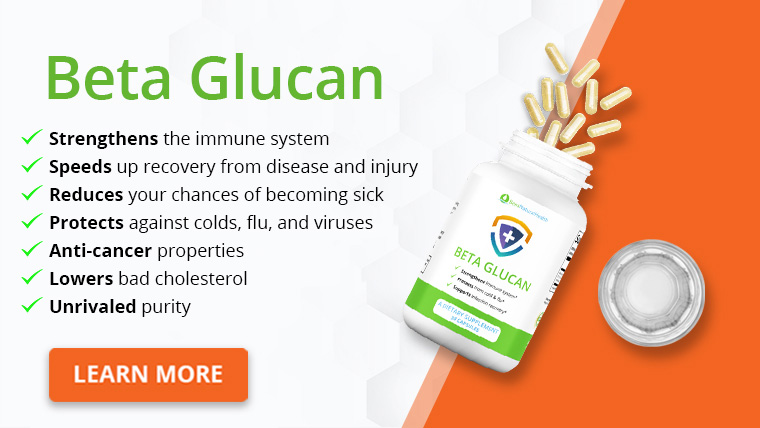There’s a reason the quote “Let food be your medicine” (Hippocrates) is often referenced.
Food does more than satisfy hunger and help you stay alive.
Many foods can help you thrive and improve your health, wellness, and longevity.
Beta-glucan is a nutrient with powerful health benefits and is found in several foods, some of which you might already have in your pantry.
Keep reading to learn 10 foods that are high in beta glucan.
What is beta-glucan?
Beta-glucan, or β-glucan, is a type of dietary fiber found in plant-based foods. Beta-glucan is a type of dietary fiber which is a part of plant foods that aren’t absorbed by your digestive tract. There are two types of fiber: soluble and insoluble.
Beta-glucan is a type of soluble fiber. This means it absorbs water and swells in your digestive system. Soluble fiber can slow digestion time because it takes longer to pass through your intestines.
Dietary fiber is known for its many health benefits, including digestive, immune, and heart health. Beta-glucan, in particular, has been studied for its health-promoting properties.

What are the benefits of beta-glucan?
Lowering cholesterol
Beta-glucans have been used to treat high cholesterol since the 1960s (1). Beta-glucans help lower LDL cholesterol, which is known as “bad cholesterol” because it can increase your risk of heart disease.
While they lower LDL cholesterol, beta-glucans don’t lower HDL cholesterol, which is known as “good cholesterol.” Unlike LDL cholesterol, high HDL levels are beneficial and can lower your risk factors for heart disease.
Doses of three grams of beta-glucan daily have been shown to reduce LDL cholesterol by 5-10% in people with both normal and high cholesterol levels (2).
May help lower blood sugar
Eating fiber-rich foods like beta-glucans might help promote more stable blood sugar levels by slowing digestion time. When the food you eat is digested more slowly, your body can more efficiently control the rise in blood sugar levels by releasing enough insulin in response to the rise.
According to studies, beta-glucans help reduce blood sugar levels after meals, which means they can be a part of a healthy diet to control diabetes (3).
Immune system health
Dietary fiber like beta-glucan acts as a prebiotic, meaning they feed probiotics (good bacteria) in your gut.
Your gut plays a large role in your immune system health. Dietary fiber, including beta-glucan, feeds beneficial bacteria in your digestive system that help support your immune system. If you don’t have enough healthy bacteria in your gut, you might be more predisposed to illness.
Anti-inflammatory
Inflammation plays a role in many of today’s most prevalent chronic diseases, such as heart disease, type 2 diabetes, and cancer.
Beta-glucans can help reduce inflammation by suppressing levels of pro-inflammatory substances that increase inflammation (4).
In addition, beta-glucans are a source of antioxidants. Antioxidants help fight oxidative stress, which contributes to inflammation. According to a study, the antioxidant activity is highest in barley beta-glucans (5).

10 foods high in beta-glucan
1) Oats
Oats are naturally rich in beta-glucan, which is one of the reasons oatmeal is recommended to help lower cholesterol levels.
You can eat oatmeal on its own or grind it and make oat flour to use in baked goods. Oats are also naturally gluten-free, making them a good choice for those with gluten or wheat sensitivities.
One-half cup of dry oats contains around 4 grams of fiber. The beta-glucan content of oats varies but averages around 3-5% by weight.
2) Barley
Barley is one of the highest-fiber grains you can eat. Along with oats, it is one of the richest sources of beta-glucan.
Barley grass is a form of barley in its young state. Barley grass not only contains beta-glucan but it has anti-cancer properties as well. According to a study, barley grass extract helped kill breast and prostate cancer cells (6).

3) Reishi mushrooms
Reishi mushrooms grow in hot and humid areas in Asia and have been used in Eastern medicine to help enhance the immune system, improve sleep, reduce stress, and fight fatigue.
Reishi mushrooms are used to treat chronic health conditions like high blood pressure, high cholesterol, certain infections, and more.
Studies on reishi mushrooms confirm their anti-cancer effects. The type of beta-glucans in reishi mushrooms appear to be more bioavailable (better absorbed), making them a good choice for adjunct therapy to treat health problems (7).
Reishi mushrooms have a distinct shape, are kidney-shaped, and have a deep red/brown color, which can help you set them apart from other types of mushrooms.
4) Shiitake mushrooms
Shiitake mushrooms are one of the most popular types of edible mushrooms and are rich in beta-glucan. Shiitake mushrooms are a rich plant-based source of vitamin D and are high in vitamins B1, B2, B12, C, and niacin (B3).
These mushrooms are versatile and can be used in stir-fries, pasta, soup, pizza, or as a side dish when sauteed. Enjoying shiitake mushrooms regularly can help improve your immune system health, according to a small study on 52 healthy adults (8).
5) Nutritional yeast
Nutritional yeast is a type of deactivated brewer’s yeast, so it’s not alive. Nutritional yeast is popular among vegans and vegetarians because it’s naturally rich in protein and vitamin B12, a nutrient found primarily in animal products.
It comes in a powdered/flake form and has a savory, cheesy flavor, making it popular for vegan cheese substitutes and savory sauces.
6) Seaweed
Seaweed and algae contain beta-glucan, which is usually extracted and used in supplements for convenience. Brown algae is also a source of beta-glucans.
Seaweed is also a source of vitamins A, C, and E, which act as antioxidants and may help reduce inflammation.

7) Rye bread
Rye bread is made from rye grain and can vary in darkness depending on the amount of rye flour used.
100% rye bread has a different taste and texture than rye bread made with wheat flour, and it doesn’t rise like wheat bread. Because of this, rye flour is typically combined with wheat flour to offset the denser texture and stronger flavor.
8) Whole wheat bread
Whole wheat bread is naturally rich in beta-glucan. Whole wheat/whole grain bread is made using all parts of the wheat kernel, including the bran and germ. On the other hand, white bread and some types of multigrain bread using white flour are stripped of the bran and germ, removing fiber, protein, and beneficial nutrients.
In order to ensure you’re getting whole wheat bread, check the ingredients label and try to avoid those with enriched flour in the ingredients list. Whole grain bread usually has at least three grams of fiber per slice.
9) Baker’s yeast
Baker’s yeast is a popular yeast strain for bread making. Yeast helps bread rise by consuming sugar and releasing alcohol and carbon dioxide gas, which helps inflate air bubbles in the dough.
Baker’s yeast is so rich in beta-glucan that a strain of it is sold as an additive for food, beverage, and supplement manufacturers to help support immune health.
10) Sorghum
Sorghum is a species of grass and is considered an ancient grain. Sorghum is primarily used in animal feed and the production of ethanol. However, it’s gaining popularity for its use as an additive to processed foods like cereals and granola bars.
Sorghum can also be used as a sweetener in the form of sorghum syrup, as well as a substitute for rice in risotto dishes.
While the beta-glucan content of sorghum isn’t as high as wheat or rye, it does contain some. However, soaking sorghum increases its beta-glucan content.
Conclusion
Beta-glucan is a type of soluble fiber with numerous health benefits backed by scientific research. The best sources of beta-glucan are grains like wheat, oats, and rye. Mushrooms and some types of yeast are also very good sources of beta-glucan.
Eating foods naturally rich in beta-glucan may help promote your health by improving your cholesterol levels, boosting your immune system health, and reducing inflammation.
Explore More







